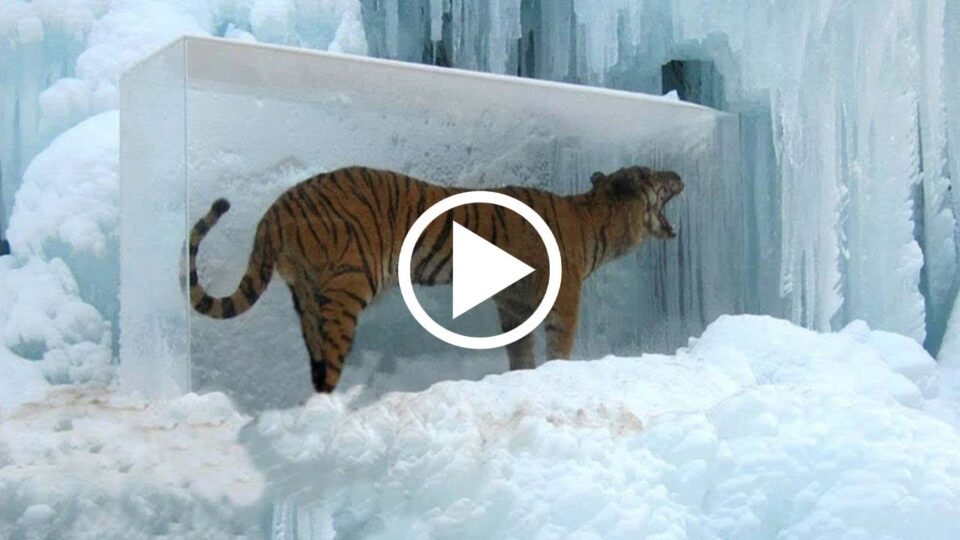Imagine going for a nice walk during the winter in the country and coming across a wild animal frozen and engulfed in ice? What about two animals about to battle it out on the cold tundra but are unable to because they were frozen in time.
This sounds unbelievable, doesn’t it? Well, if you want to see some of these amazing creatures frozen in time, stick around and pay attention as we countdown 15 shocking animals that were frozen in ice. Get that Slush Puppy and thank God you are in the comfort of your home watching this!
15 – Alligator
Number 15 on our list is the Alligator. Alligators in North Carolina went into a deep freeze this week as a blast of winter cold gripped the region. Gators at The Swamp Park in Ocean Isle Beach froze in place with their noses sticking out of the icy water so they could breathe. I thought these lizards were brainless, but they’re smarter than they look.
Swamp Park manager George Howard said 18 American alligators at the park froze Monday night and stayed frozen all day Tuesday. The alligators seem to sense when the water is about to hit the freezing point and they poke their noses into the air at just the right moment.
When the water or air temperatures dip too low for them to be active, the cold-blooded reptiles go into a state of brumation. Brumation is a hibernation-like state for reptiles.
The same phenomenon happened last winter when gators in the 65-acre park and sanctuary froze with their noses sticking out of the swap and the images went viral. Those alligators thawed out within days and had no apparent injuries because of their deep freeze. Aren’t lizards cold-blooded?
14–FISHY WALL
Number 14 on our list is the Fishy wall. The fish in this video look as if they have frozen to death mid-jump. But what really happened is more complicated.
And while it’s easy to feel sorry for the frozen fish and worry that something has gone wrong, you can take comfort because their deaths were part of an ecological reboot for the lake where they died. Sometimes nature seems harsh, but it is all a part of the life cycle of a wetland.
The National Wildlife Refuge System, part of the United States Fish and Wildlife Service, first shared the photo on its Facebook page as part of a picture captioning contest in December.
But it received renewed attention this week after the Department of Interior shared it on Twitter. It amazed people to see a four-foot wall of frozen fish while birding in Lake Andes National Wildlife Refuge in South Dakota.
But commenters on Facebook reported seeing something like it before. And in 2014, a man and his miniature schnauzer stumbled upon an entire school of frozen pollock along the surface of a bay in Norway.
The man thought the fish had gotten trapped in the bay while trying to escape a predator, and then powerful winds and freezing temperatures froze the fish in place. They found no mosquitos in the vicinity!
13 – THE CAVE LION IN SIBERIA
Number 13 on our list is the Cave Lion in Siberia. Most discoveries from the fossil record leave a lot to the imagination: scattered teeth, partial skeletons, and tantalizing footprints are classic examples.
But a new discovery from the Asian Arctic is exceeding–and excitingly–abnormal: a baby cave lion so pristinely preserved that you can still see its expression.
They estimate this beautiful animal to be at least 20,000 years old, but it doesn’t look it, aside from belonging to a long-extinct species!
Eyes closed, with its head still resting on the paw curled under its chin, the little lion has been frozen in time by the Siberian permafrost, since its death during the peak of the last Ice Age glaciation. The tiny cave lion is only about 18in long, estimated to have been two months old when it died.
The permafrost of northern Asia is well known for producing frozen juvenile animals: There are no traces of external injuries on the skin. This new cave lion has only just been unveiled, and the scientists involved now have a lot to learn about it.
For starters, they plan to look at their teeth to determine more precisely how old it was at the time of death. They should also be able to figure out its sex, and how long ago it lived. It sounds like his life is just beginning for our cave lion!


